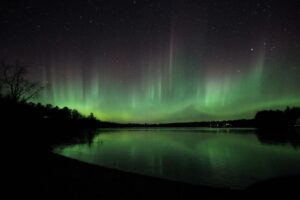What’s Up in the Night Sky?
Our northern lakes and skies are often photographed to capture fabulous sunrises and sunsets. We have another reason to cast our eyes on the horizon in the Park Rapids area: The Northern Lights frequently brighten the night sky, especially in the fall and spring.
In the Park Rapids area, we are fortunate to live where night skies can be seen away from city lights. Sometimes, northern lights flicker brightly overhead. Odds may be better with a clear north view, notably across a lake or field. Best viewing hours are typically between 10 p.m. and 2 a.m.

Here Are Some Local Places to Catch the Phenomenon:
- South shore of Fish Hook Lake: A public access is located on the south shore of Fish Hook Lake, a short distance north of the city limits on US Hwy. 71.
- South shore of Lake Emma: A public access is located on Hubbard County Hwy. 40 on the south shore of Lake Emma.
- Highway 34 West: Along the north side of state Highway 34 west of Park Rapids, many fields provide an unobstructed view of the northern sky.
- Itasca State Park: Below Douglas Lodge, visitors can look across Lake Itasca at a broad northern horizon. The park closes at 10 p.m., so you might need some luck to stay there when the Northern Lights grace the horizon.
A Heads Up From the Experts
Watching the pulsing streams of greens, purples, and reds seems magical, whether it’s your first time or the tenth. To our benefit, weather forecasters have become quite good at giving us a heads-up when the Northern Lights might appear. Even predicting what hours we will most likely see them.
The National Oceanic and Atmospheric Administration (NOAA) also has a website with a 30-minute forecast of the probability of seeing the Aurora Borealis:
https://www.swpc.noaa.gov/products/aurora-30-minute-forecast.
Another forecaster is https://www.spaceweather.com/.
Also, Northern Lights Alert Facebook group: https://www.facebook.com/groups/154848124616342.
Capture the wonder on your phone!
Most cell phones will work if you want to capture a photo of the Northern Lights. Just be sure to keep your phone still for a more prolonged exposure. A rock or other prop or velcro could work if you don’t have a phone stand. One photographer shot a photo of the Northern Lights that she could barely see with her naked eye, but they looked bright in a photo she took using her cell phone.
As long as you have a clear view of the sky overhead or in any direction and clouds don’t get in the way, our rural, deep, dark skies are an open window on the Milky Way, shooting stars and meteor showers, too.
Keep looking up!


